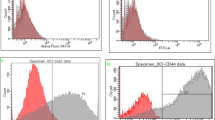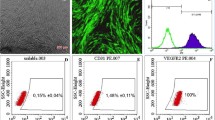Abstract
Background
Tissue ischemia usually leads to necrosis and is a threatening condition associated with reconstructive surgery. Promoting the survival of ischemic tissue is critical for improving clinical outcomes. Although various solutions based on stem cells have been reported, there are still limitations to clinical translation. The aim of this study was to develop an effective method to promote the survival of ischemic tissue.
Methods
Adipose-derived CD34 + and CD34- cells were obtained by magnetic bead sorting from the stromal vascular faction (SVF). Adipose-derived stem cells (ADSCs) were collected by subculture. The angiogenic capacities of CD34 + cells, CD34- cells and ADSCs were evaluated in vitro by comparing mRNA and protein expression. Random axial flaps in nude mice were used to evaluate the efficacy of these cells in protecting tissue from necrosis. The effect of these cells in preventing inflammation was also evaluated.
Results
Our data suggest that CD34 + cells expressed higher levels of angiogenetic factors and lower levels of inflammatory factors than the other cell types. More vessel branches were formed when human umbilical vein endothelial cells (HUVECs) were treated with conditioned medium from CD34 + cells than conditioned medium from the other cell types. Compared to ADSCs, CD34 + cells showed significantly higher efficacy in promoting tissue survival. More CD31 + cells and higher levels of angiogenic factors were observed in tissues from the CD34 + group than in those from the other groups. Lower levels of the proinflammatory factors TNF-α and IL-1b and higher levels of anti-inflammatory factors were found in the CD34 + group than in the other groups.
Conclusion
Adipose-derived CD34 + cells showed better efficacy in improving ischemic tissue survival than ADSCs by reducing tissue inflammation and promoting angiogenesis. CD34 + cells can be obtained easily and may be suitable for clinical applications.
Graphical abstract







Similar content being viewed by others
Abbreviations
- ADSC:
-
adipose-derived stem cell
- BSA:
-
bovine serum albumin
- EPCs:
-
endothelial progenitor cells
- HSCs:
-
hematopoietic stem cells
- HUVECs:
-
human umbilical vein endothelial cells
- MSCs:
-
mesenchymal stem cells
- PVDF:
-
polyvinylidene difluoride
References
Bromage, D. I., Taferner, S., He, Z., et al. (2019). Stromal cell-derived factor-1α signals via the endothelium to protect the heart against ischaemia-reperfusion injury. Journal of Molecular and Cellular Cardiology, 128, 187–197. https://doi.org/10.1016/j.yjmcc.2019.02.002
Butko, A., Bonat Celli, G., Paulson, A., et al. (2016). Entrapment of basic fibroblast growth factor (bFGF) in a succinylated chitosan nanoparticle delivery system and release profile. Journal of Biomaterials Science, Polymer Edition, 27(10), 1045–1057. https://doi.org/10.1080/09205063.2016.1178519
Eto, H., Ishimine, H., Kinoshita, K., et al. (2013). Characterization of human adipose tissue-resident hematopoietic cell populations reveals a novel macrophage subpopulation with CD34 expression and mesenchymal multipotency. Stem Cells Dev, 22(6), 985–997. https://doi.org/10.1089/scd.2012.0442
Ferrara, N., & Alitalo, K. (1999). Clinical applications of angiogenic growth factors and their inhibitors. Nature Medicine, 5(12), 1359–1364. https://doi.org/10.1038/70928
He, X. Y., Antao, V. P., Basila, D., et al. (1992). Isolation and molecular characterization of the human CD34 gene. Blood, 79(9), 2296–2302.
Huang, G., Lin, Y., Fang, M., et al. (2019). Protective effects of icariin on dorsal random skin flap survival: An experimental study. European Journal of Pharmacology, 861, 172600. https://doi.org/10.1016/j.ejphar.2019.172600
Ju, J., Wu, J., & Hou, R. (2016). Role of the p38 mitogen-activated protein kinase signaling pathway in estrogen-mediated protection following flap ischemia-reperfusion injury. Cell Biochemistry and Function, 34(7), 522–530. https://doi.org/10.1002/cbf.3226
Kazenwadel, J., & Harvey, N. L. (2018). Lymphatic endothelial progenitor cells: Origins and roles in lymphangiogenesis. Current Opinion in Immunology, 53, 81–87. https://doi.org/10.1016/j.coi.2018.04.012
Kobolak, J., Dinnyes, A., Memic, A., et al. (2016). Mesenchymal stem cells: Identification, phenotypic characterization, biological properties and potential for regenerative medicine through biomaterial micro-engineering of their niche. Methods, 99, 62–68. https://doi.org/10.1016/j.ymeth.2015.09.016
Lee, S. H., Lee, J. H., Yoo, S. Y., et al. (2013). Hypoxia inhibits cellular senescence to restore the therapeutic potential of old human endothelial progenitor cells via the hypoxia-inducible factor-1α-TWIST-p21 axis. Arteriosclerosis, Thrombosis, and Vascular Biology, 33(10), 2407–2414. https://doi.org/10.1161/atvbaha.113.301931
Li, J., Tan, J., Martino, M. M., et al. (2018). Regulatory T-Cells: Potential Regulator of Tissue Repair and Regeneration. Frontiers in Immunology, 9, 585. https://doi.org/10.3389/fimmu.2018.00585
Li, N., & Hua, J. L. (2017). Interactions between mesenchymal stem cells and the immune system. Cellular and Molecular Life Sciences, 74(13), 2345–2360. https://doi.org/10.1007/s00018-017-2473-5
Liu, N., Matsumura, H., Kato, T., et al. (2019). Stem cell competition orchestrates skin homeostasis and ageing. Nature, 568(7752), 344–350. https://doi.org/10.1038/s41586-019-1085-7
Maumus, M., Peyrafitte, J. A., D’Angelo, R., et al. (2011). Native human adipose stromal cells: Localization, morphology and phenotype. International Journal of Obesity, 35(9), 1141–1153. https://doi.org/10.1038/ijo.2010.269
Mushahary, D., Spittler, A., Kasper, C., et al. (2018). Isolation, cultivation, and characterization of human mesenchymal stem cells. Cytometry. Part A, 93(1), 19–31. https://doi.org/10.1002/cyto.a.23242
Nguyen, A., Guo, J., Banyard, D. A., et al. (2016). Stromal vascular fraction: A regenerative reality? Part 1: Current concepts and review of the literature. Journal of Plastic, Reconstructive & Aesthetic Surgery, 69(2), 170–179. https://doi.org/10.1016/j.bjps.2015.10.015
Pan, X. Y., Peng, L., Han, Z. Q., et al. (2015). Hirudin promotes angiogenesis by modulating the cross-talk between p38 MAPK and ERK in rat ischemic skin flap tissue. Tissue and Cell, 47(3), 301–310. https://doi.org/10.1016/j.tice.2015.04.001
Peng, L., Pan, X., & Yin, G. (2015). Natural Hirudin Increases Rat Flap Viability by Anti-Inflammation via PARs/p38/NF-κB Pathway. BioMed Research International, 2015, 597264. https://doi.org/10.1155/2015/597264
Riss, T. L., Moravec, R. A., Niles, A. L., et al. (2004). Cell Viability Assays. In S. Markossian, A. Grossman, K. Brimacombe, M. Arkin, D. Auld, C. P. Austin, J. Baell, T. D. Y. Chung, N. P. Coussens, J. L. Dahlin, V. Devanarayan, T. L. Foley, M. Glicksman, M. D. Hall, J. V. Haas, S. R. J. Hoare, J. Inglese, P. W. Iversen, S. C. Kales, … X. Xu (Eds.), Assay Guidance Manual. Bethesda (MD).
Selvaprithviraj, V., Sankar, D., Sivashanmugam, A., et al. (2017). Pro-angiogenic Molecules for Therapeutic Angiogenesis. Current Medicinal Chemistry, 24(31), 3413–3432. https://doi.org/10.2174/0929867324666170724142641
Sidney, L. E., Branch, M. J., Dunphy, S. E., et al. (2014). Concise review: Evidence for CD34 as a common marker for diverse progenitors. Stem Cells, 32(6), 1380–1389. https://doi.org/10.1002/stem.1661
Wang, Z., Yi, T., Long, M., et al. (2017). Electro-Acupuncture at Zusanli Acupoint (ST36) Suppresses Inflammation in Allergic Contact Dermatitis Via Triggering Local IL-10 Production and Inhibiting p38 MAPK Activation. Inflammation, 40(4), 1351–1364. https://doi.org/10.1007/s10753-017-0578-5
Wu, H. Q., Ding, J., Wang, L., et al. (2018). Valproic acid enhances the viability of random pattern skin flaps: Involvement of enhancing angiogenesis and inhibiting oxidative stress and apoptosis. Drug Design Development and Therapy, 12, 3951–3960. https://doi.org/10.2147/Dddt.S186222
Zhang, X., Zuo, X., Yang, B., et al. (2014). MicroRNA directly enhances mitochondrial translation during muscle differentiation. Cell, 158(3), 607–619. https://doi.org/10.1016/j.cell.2014.05.047
Acknowledgements
The authors gratefully acknowledge the technology support from the Core Facility of Basic Medical Sciences, Shanghai Jiao Tong University School of Medicine. We thank American Journal Experts (AJE) for editing the English language of the manuscript. Figures were created using Microsoft Powerpoint and Biorender.
Funding
This study was supported by the National Natural Science Foundation of China (81971848; 81620108019); Clinical Research Plan of SHDC (SHDC2020CR1019B; SHC2020CR402); Shanghai Municipal Key Clinical Specialty (shslczdzk00901); and Innovative Research Team of High-level Local University in Shanghai (SSMU-ZDCX20180700).
Author information
Authors and Affiliations
Contributions
YJL, SBZ and QFL initiated and designed the study and protocol. SBZ and YX recruited all patients. YJL, TYZ and PCT participated in the data collection and data analysis. PCT and PQZ contributed to the data interpretation. TYZ and PCT wrote the first draft of the manuscript, and QFL and SBZ critiqued and modified the manuscript. All authors reviewed and approved the work.
Corresponding author
Ethics declarations
Ethics Approval and Consent to Participate
The donors of abdominal subcutaneous adipose tissues all provided informed consent. This study was approved by the Ethics Committee of Shanghai Ninth People's Hospital and complied with the principles of the Declaration of Helsinki. Consent to participate is not applicable.
Consent for Publication
Not applicable.
Graphical Illustrations
Graphical illustrations were made with Biorender.com.
Data Availability
The datasets used and/or analyzed during the current study are available from the corresponding author on reasonable request.
Competing Interests
The authors declare that they have no competing interests.
Additional information
Publisher's Note
Springer Nature remains neutral with regard to jurisdictional claims in published maps and institutional affiliations.
Supplementary Information
Below is the link to the electronic supplementary material.
Rights and permissions
About this article
Cite this article
Liu, YJ., Zhang, TY., Tan, PC. et al. Superiority of Adipose-derived CD34 + Cells over Adipose-derived Stem Cells in Promoting Ischemic Tissue Survival. Stem Cell Rev and Rep 18, 660–671 (2022). https://doi.org/10.1007/s12015-021-10276-x
Accepted:
Published:
Issue Date:
DOI: https://doi.org/10.1007/s12015-021-10276-x




